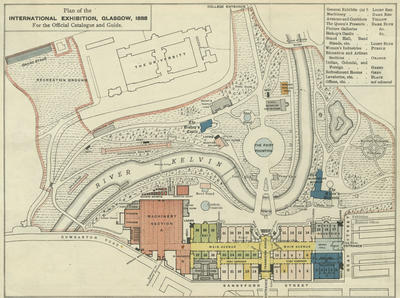
Glasgow's first major exhibition was the International Exhibition of 1888. Its main aim was to draw attention to the city's achievements in science, industry and art. However, it was also hoped the Exhibition would raise enough money for a much-needed museum, art gallery and school of art in the city.
Civic pride demanded that the exhibition be constructed on a grand scale so that it was not to be outshone by exhibitions in other cities, notably Edinburgh and Manchester. Architect James Sellars decided on an oriental style which "lends itself readily to execution in wood." The buildings were of course temporary, and consideration had to be given to ease of dismantling them once the exhibition was over.
The Main Building, which housed most of the exhibits, occupied an area of Kelvingrove Park between the River Kelvin and Sandyford Street which nowadays is the western end of Sauchiehall Street. It was thought fitting that attractions which were intended to broaden the exhibition's appeal should be kept separate from the main exhibits and they were sited in the area between the University and the River Kelvin.
Reference: Mitchell Library, GC 606.4 (1888)
Reproduced with the permission of Glasgow City Council, Libraries Information and Learning
Keywords:
art, art galleries, exhibitions, industry, International Exhibition 1888, Kelvingrove Park, museums, River Kelvin, science, University of Glasgow, wooden buildings
You have 0 images in your photo album.